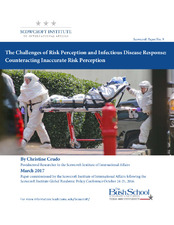| dc.description.abstract | In 2014 an Ebola epidemic swept through western Africa, killing tens of thousands of people. When a case of the virus appeared in Dallas, TX, the American public began to panic. There was concern that the disease would spread quickly and uncontrollably like it had in Africa. Much of the fear and anxiety surrounding Ebola in the United States was perpetuated by a lack of understanding about the virus and a highly exaggerated perception of the chance of infection; an inaccurate perception fueled by the CDC’s poor communication throughout the outbreak. Many Americans did not understand that a main reason Ebola was able to spread so rapidly in Africa was due to lack of personal protective equipment— specifically gloves—, a lack of infrastructure and properly trained healthcare workers, and the traditional burial practices of many of the affected communities (WHO, 2015). In reality, the American healthcare system, with the addition of designated definitive treatment centers and appropriate use of personal protective equipment, is fully equipped and capable of safely containing cases of Ebola virus, which is most commonly spread through contact with infected bodily fluids, similar to HIV.
What motivates most of the misperceptions about diseases like Ebola is fear and a lack of understanding about disease transmission. Fear is a difficult emotion to overcome. It is a primal response; a survival instinct. It often takes over logical thinking. Panic or an unrealistic level of fear can be one of the greatest challenges facing public health officials during an infectious disease outbreak. Exaggerated fear makes it unlikely that a disease will spread, but it can have a disproportion economic impact, as was the case with Severe Acute Respiratory Syndrome (SARS) in 2003.
Inaccurate levels of fear can also be a challenge when the situation is reversed and the public’s perception of the risk is lower than the reality of the risk. Lower than realistic risk perception is an obstacle health authorities face every influenza season. “The flu” is often used as a catch-all term when people are feeling under the weather and it is difficult for the public to understand how deadly the influenza virus can be. The CDC estimates that during the 2014 flu season there were 707,155 influenza-related hospitalizations and 19,490 influenza-related deaths in the United States (CDC, 2016a), while there was 11,310 Ebola deaths in West Africa that same year (CDC, 2016b). A lower than realistic risk perception of influenza means that many people do not get a flu shot or take any sort of protective measures against infection.
This article examines how risk perception affects the public’s ability and willingness to follow recommended actions during a disease outbreak. I also seek to identify the most significant challenges in changing risk perception and provide suggestions for doing so. | en |


